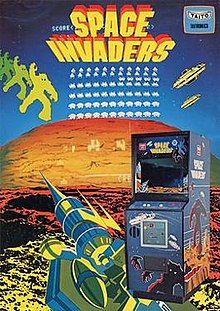
Back Space Invaders AN سبيس إنفيدرز Arabic سپيس انڤيدرز ARZ Space Invaders AST Space Invaders Azerbaijani Space Invaders Catalan Space Invaders Czech Space Invaders Welsh Space Invaders (computerspil) Danish Space Invaders German
| Space Invaders | |
|---|---|
 Arcade flyer | |
| Developer(s) | Taito |
| Publisher(s) | Atari, Inc. (home) |
| Designer(s) | Tomohiro Nishikado |
| Series | Space Invaders |
| Platform(s) | Arcade, Atari 2600, Atari 5200, Atari 8-bit, MSX, handheld, tabletop, watch, calculator,[9] NES,[10] SG-1000,[11] WonderSwan,[12] VG Pocket,[13] mobile,[14] iOS[15] |
| Release | Arcade |
| Genre(s) | Fixed shooter |
| Mode(s) | 1–2 players alternating turns |
Space Invaders[b] is a 1978 shoot 'em up arcade video game, developed and released by Taito in Japan and licensed to Midway Manufacturing for overseas distribution. Commonly considered to be one of the most influential video games of all time, Space Invaders was the first fixed shooter and the first video game with endless gameplay (meaning there was no final level or endscreen) and set the template for the genre. The goal is to defeat wave after wave of descending aliens with a horizontally moving laser cannon to earn as many points as possible.
Designer Tomohiro Nishikado drew inspiration from North American target shooting games like Breakout (1976) and Gun Fight (1975), as well as science fiction narratives such as the novel The War of the Worlds (1897), the anime Space Battleship Yamato (1974), and the film Star Wars (1977). To complete development, he had to design custom hardware and development tools. Upon release, Space Invaders was an immediate commercial success; by 1982, it had grossed $3.8 billion ($14 billion in 2023-adjusted terms),[16] with a net profit of $450 million ($1.7 billion in 2023 terms). This made it the best-selling video game and highest-grossing entertainment product at the time, and the highest-grossing video game of all time.
Space Invaders is considered one of the most influential video games ever made, having ushered in the golden age of arcade video games. It was the inspiration for numerous video games and game designers across different genres, and has been ported and re-released in various forms. The 1980 Atari VCS version quadrupled sales of the VCS, thereby becoming the first killer app for video game consoles. More broadly, the pixelated enemy alien has become a pop culture icon, often representing video games as a whole.
- ^ Akagi, Masumi (October 13, 2006). アーケードTVゲームリスト国内•海外編(1971–2005) [Arcade TV Game List: Domestic • Overseas Edition (1971–2005)] (in Japanese). Japan: Amusement News Agency. p. 124. ISBN 978-4990251215.
- ^ "Chicago Chatter: Happy Birthday "Space Invaders."". Cash Box. October 25, 1980.
- ^ "Space Invaders (Registration Number PA0000120007)". United States Copyright Office. Retrieved June 1, 2021.
- ^ Akagi, Masumi (October 13, 2006). アーケードTVゲームリスト国内•海外編(1971–2005) [Arcade TV Game List: Domestic • Overseas Edition (1971–2005)] (in Japanese). Japan: Amusement News Agency. pp. 40–1. ISBN 978-4990251215.
- ^ Shibata, Yoko (June 28, 1979). "Electronic Games: Japan converts its Pachinko parlours". Financial Times.
- ^ Cite error: The named reference
ACEwas invoked but never defined (see the help page). - ^ European releases:
- ^ Space Invaders (AU), The Arcade Flyer Archive
- ^ Cite error: The named reference
Cohenwas invoked but never defined (see the help page). - ^ Cite error: The named reference
RG-41was invoked but never defined (see the help page). - ^ [1] Archived November 21, 2011, at the Wayback Machine
- ^ "Space Invaders for WS". GameSpot. Archived from the original on September 6, 2004. Retrieved September 3, 2008.
- ^ Block, Gerry (September 26, 2006). "VG Pocket Caplet Review". IGN. Retrieved September 7, 2008.
- ^ "NTTドコモ「FOMAR 904i」向けに新コンテンツ提供!!" (in Japanese). Taito. Archived from the original on May 27, 2011. Retrieved June 29, 2009.
- ^ Crecente, Brian (August 3, 2009). "pace Invaders Infinity Gene Micro-Review: Evolve or Die". Kotaku. Archived from the original on June 19, 2010. Retrieved June 15, 2010.
- ^ Hansen, Dusty (2016). Game On! Video Game History From Pong and Pac-Man to Mario, Minecraft and More. MacMillan Publishing Group, LLC. p. 11. ISBN 978-1-250-08095-0.
Cite error: There are <ref group=lower-alpha> tags or {{efn}} templates on this page, but the references will not show without a {{reflist|group=lower-alpha}} template or {{notelist}} template (see the help page).
© MMXXIII Rich X Search. We shall prevail. All rights reserved. Rich X Search